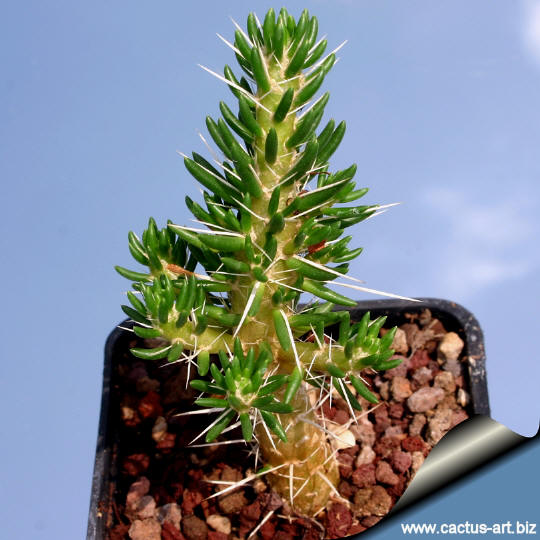|
|
Family:
Cactaceae (Cactus
Family)
Scientific name:
Maihuenia poeppigii (Ottp ex
Pfeiffer) Philippi ex. K. Schumann in 1898
Origin: Southern Chile, but also crosses the border into
western Argentina at places.
Habitat: Grows at very high altitudes of
above 1500 m in extremely xeric regions of Patagonia mainly in volcanic
ashfields in subalpine forests, thin grassland and stony plateaux.
Conservation status: Listed in
CITES appendix 2.
Synonyms:
- Opuntia poeppigii Ottp ex
Pfeiffer 1837
Closest relatives: Maihuenias are very strange and unusual cacti
that in earlier literature were supposed to be related to Opuntia,
Pereskia and Pereskiopsis, but DNA sequencing of
this group has determined that Maihuenia is not related to any of
those.
|
|
Description: Plant forming large mats of cylindrical stems with
small, succulent leaves and white spines, often consisting of hundreds of
individual segments. It is small in size, and can reach 15 cm
in height, but
it can grow up to more than a meter in diameter.
Leaves: The foliage is formed by a dense mass of dark green,
cylindrical and almost needle-like leaves. It keeps its leaves in the
winter.
Flowers: Remarkably beautiful, large, soft, satiny, lemon-yellow.
Blooming season: Late spring.
|
|
|
|

Cultivation: Maihuenia
poeppigii is an easy-to-grow plant, it is a surprisingly
moisture-tolerant cactus, is said also to be reliably cold-hardy in
central Europe and England. Of the two species Maihuenia poeppegii is
the hardiest species and it can survive outside in the garden in the
sunny rockery on a sheltered place, but only if it's protected with a
sheet of glass during the wintertime. It is also very good for a large
pot which can be stored inside an unheated greenhouse or on a balcony,
somewhat protected from moisture during the winter, but is probably
safest to grow it in the Alpine House or in a raised bed inside an
unheated greenhouse all year around, with lots of ventilation.. It
doesn't fear cold weather and it bears very harsh frost, and
temperatures of around -10° (or less down to -20° if dry) degrees
Celsius did not harm these plants at all. They should not be kept hot in
summer as they are from high elevations. during the beautiful season
it’s good to enrich the soil of our succulent plants; using a fertilizer
rich in potassium and phosphorous, but poor in nitrogen, because this
chemical element doesn’t help the development of succulent plants,
making them too soft and full of water. For a balanced development, it is
best to position the the Maihuenia poeppigii in a place where it is
exposed to at least a few hours of direct sunlight. Water these
plants only from time to time if grown outdoors, but
it should be watered
abundantly if grown in a pot or in the greenhouse, during the summer. The
spring weather, with a high temperature swing between the day and night
hours, and pretty frequent rains, can favour the development of fungus
diseases, which should be treated pre-emptively with a systemic
fungicide. We suggest repotting every 2-3 years.
This species can also be grown anchored without soil on a roof (like for
the sempervivums).
|
|

 |
|